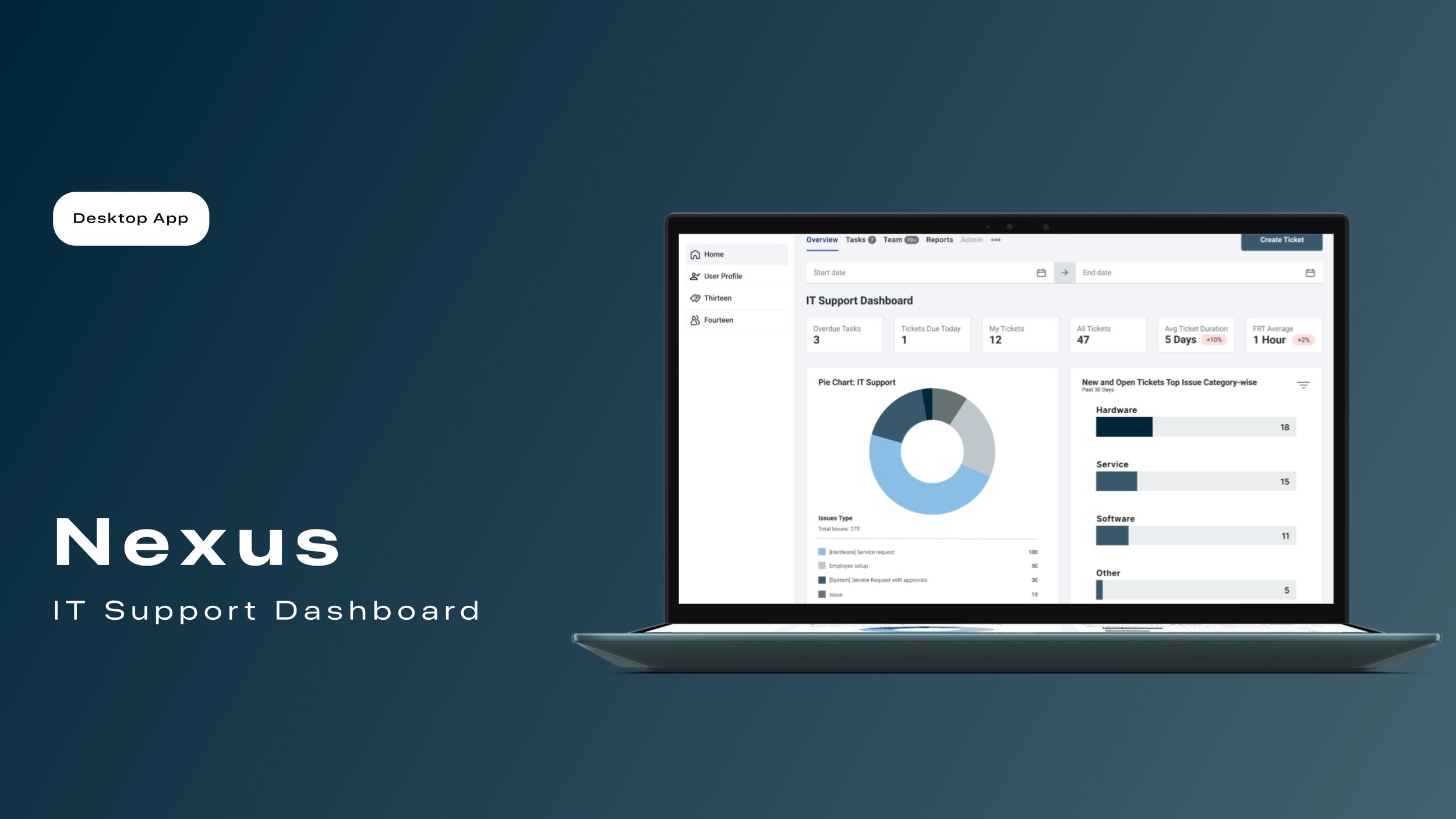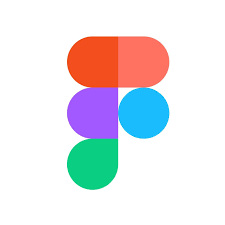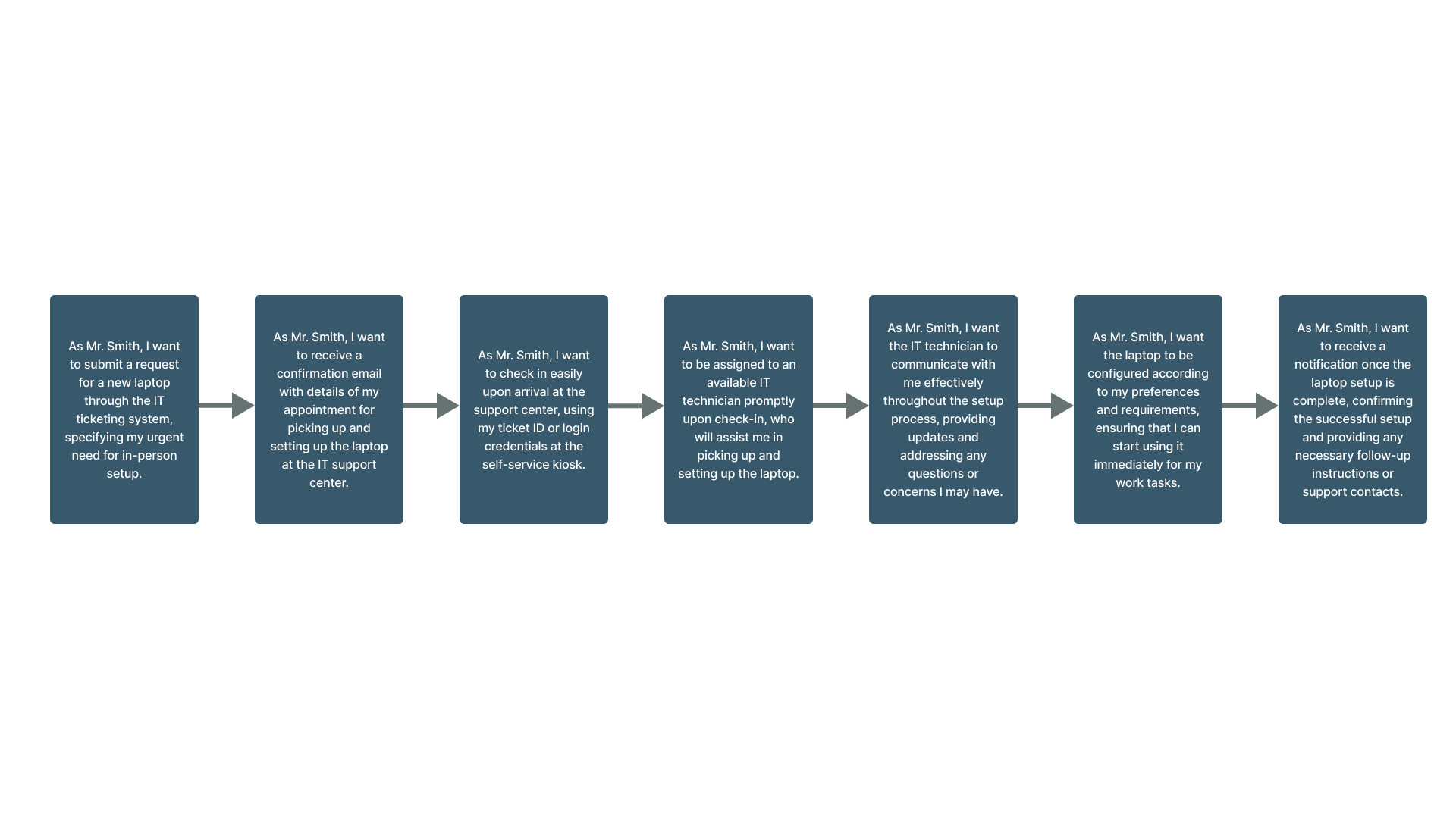
Project Overview
Background:
The Pinnacle IT Support Center faced significant challenges due to the lack of standardized processes, integrated tools, and actionable, decision-ready data. These limitations hindered their ability to manage resources efficiently and affected the quality of service provided to their customers.
Objective:
The primary objective of this project was to design the Nexus IT Service Management Platform, a solution that would transform the IT service experience for both the support team and the customers. The platform aimed to ensure consistent and efficient service delivery, integrate seamlessly with existing systems, and enable data-driven decision-making.
1 week (March 1 - 5, 2024)
Duration
Tools
Responsibilities
Service Design
Service Blueprint
Work Flow Analysis
User Story
User Journey Maps
Low/Mid Fidelity Prototype
Problem Statement
Streamlining IT Support for Efficient Resource Management and Decision-Making
The Pinnacle IT Support Center provides service and IT resource management for thousands of customers and resources but lacks standardized processes, integrated tools, and actionable decision-ready data.
End User Scenario:
Mr. Smith is a busy professional who needs a new laptop to stay productive at work. He wants a streamlined process that allows him to quickly request and receive IT resources without delays, confusion, or unnecessary steps. With no time for multiple follow-ups, he expects real-time updates and a seamless experience from request submission to delivery.
Solution
Designing a comprehensive IT service management platform that addresses the identified challenges and objectives.
This platform should feature:
Standardized workflows and procedures to ensure consistency and efficiency in service delivery.
Integration with existing tools and systems, such as ticketing systems, monitoring tools, and knowledge bases, to centralize information and streamline operations.
Advanced analytics and reporting functionalities to provide insights into resource utilization, service performance, and customer satisfaction.
01 Discover
User Needs
I started by reviewing the design challenge brief to understand the needs of the users. I listed assumptions, user needs, goals, and constraints based on the brief. This helped in setting a clear foundation for the project.
User Story
I created a user story for Mr. Smith to visualize his current process, highlighting pain points and opportunities for improvement. I gained a deep understanding of the user's needs, goals, and constraints, setting the foundation for the solution design.
Journey Map
To gain deeper insights, I created user journey maps for both the IT professionals and the customer, Mr. Jeffrey. These maps detailed their interactions with the system, helping to pinpoint areas for improvement in the new Nexus solution. This process helped me to become more empathetic to these users needs.
Service Blueprint
New Process
New Process:
Receive notification
Verify inventory
Nexus integrates with the asset management team alongside the IT support team. Once a notification for service, like a new laptop pick-up, is requested, Nexus checks inventory availability. If the requirement is available, Nexus creates a ticket and schedules the appointment according to IT staff availability. If the asset is out of stock, Nexus notifies the asset team to order it before setting up the appointment and assigning the ticket to IT staff.
Prepare for appointment
Once IT staff receive the laptop, they configure it to the customer's needs and update the laptop accordingly.
Meet Mr. Jefferey
The assigned IT team member meets with Mr. Jefferey to provide his equipment and answer any questions.
Resolve ticket
Recognizing that the solution needed to go beyond a user-friendly interface, I developed a service blueprint. This blueprint detailed the end-to-end service delivery process, emphasizing the importance of service design in creating an effective solution.
Workflow Analysis
Old Process
I analyzed the existing 8-step process and streamlined it into a 5-step process. My aim was to eliminate redundancies and simplify the workflow for both Mr. Smith and the IT team.
02 Ideate
High-Fidelity Prototype:
User Profile
Next, I created a high-fidelity prototype to give a polished look at the potential dashboard. This prototype illustrated how IT professionals could manage resources, track service metrics, and continuously improve service quality.
(both the user and IT team has access to this)
User Profile
IT Dashboard
03 Design
Low Fidelity
I sketched initial layouts for the Nexus platform, including the ticket system, monitoring tools, and a centralized dashboard to streamline operations, enhance inventory team collaboration, and provide insights into customer satisfaction and service performance metrics.
The focus was on layout, information architecture, and navigation.
IT Dashboard
Next Steps
If this was more than a design challenge, the next steps would include:
User Testing:
Conduct user testing sessions with both IT professionals and customers to gather feedback on the prototype. This would help identify any usability issues and areas for further improvement.
Iterative Design:
Based on user feedback, refine the design iteratively. This would involve making necessary adjustments to the workflow, user interface, and service blueprint to ensure the platform meets user needs effectively.
Development and Integration:
Collaborate with developers to build the platform, ensuring seamless integration with existing systems like ticketing and monitoring tools. This phase would also involve setting up the advanced analytics and reporting functionalities.
Training and Implementation:
Develop training materials and sessions for IT professionals to ensure they are well-equipped to use the new platform. Implement the system in stages to monitor its impact and make adjustments as needed.
Continuous Improvement:
Establish a feedback loop to continuously gather user input and performance data. Use this information to make ongoing enhancements to the platform, ensuring it evolves to meet changing user needs and organizational goals.
By following this structured approach, the Nexus platform aims to transform the IT service management experience, delivering efficient, data-driven, and user-centric solutions.



